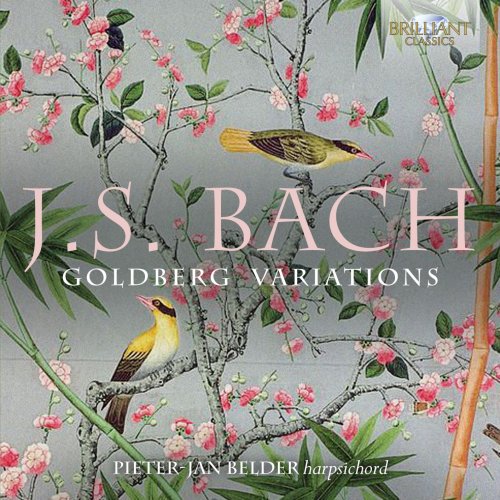Pieter-Jan Belder - J.S. Bach: Goldberg Variations (2017) [Hi-Res]

Artist: Pieter-Jan Belder
Title: J.S. Bach: Goldberg Variations
Year Of Release: 2017
Label: Berlin Classics
Genre: Classical
Quality: FLAC (tracks) / 24bit-96kHz FLAC (tracks+booklet)
Total Time: 01:17:26
Total Size: 506 MB
WebSite: Album Preview
Tracklist:Title: J.S. Bach: Goldberg Variations
Year Of Release: 2017
Label: Berlin Classics
Genre: Classical
Quality: FLAC (tracks) / 24bit-96kHz FLAC (tracks+booklet)
Total Time: 01:17:26
Total Size: 506 MB
WebSite: Album Preview
Johann Sebastian Bach (1650-1785)
Goldberg Variations, BWV 988
1 Aria 05:02
2 Variatio 1, a 1 clav. 02:14
3 Variatio 2 , a 1 clav. 01:36
4 Variatio 3, a 1 clav. - Canone all'unisono 01:55
5 Variatio 4, a 1 clav. 00:53
6 Variatio 5, a 1 ovvero 2 clav.01:49
7 Variatio 6, a 1 clav. Canone alla seconda 01:46
8 Variatio 7, a 1 ovvero 2 clav. - Al tempo di giga 01:29
9 Variatio 8, a 2 clav. 01:38
10 Variatio 9, a 1 clav. - Canone alla terza 02:51
11 Variatio 10, a 1 clav. - Fughetta 01:13
12 Variatio 11, a 2 clav. 02:12
13 Variatio 12, a 1 clav. - Canone alla quarta 02:12
14 Variatio 13, a 2 clav. 03:26
15 Variatio 14, a 2 clav. 02:18
16 Variatio 15, a 1 clav. - Canone alla quinta, andante 05:07
17 Variatio 16, a 1 clav. - Ouverture 03:08
18 Variatio 17, a 2 clav. 02:05
19 Variatio 18, a 1 clav. - Canone alla sesta 01:38
20 Variatio 19, a 1 clav. 01:11
21 Variatio 20, a 2 clav. 02:15
22 Variatio 21, a 1 clav. - Canone alla settima 02:35
23 Variatio 22, a 1 clav. - Alla Breve 01:36
24 Variatio 23, a 2 clav. 01:50
25 Variatio 24, a 1 clav. - Canone all'ottava 03:52
26 Variatio 25, a 2 clav. - Adagio 05:30
27 Variatio 26, a 2 clav. 02:14
28 Variatio 27, a 1 ovvero 2 clav. - Canone alla nona 02:04
29 Variatio 28, a 2 clav. 02:38
30 Variatio 29, a 1 ovvero 2 clav. 02:19
31 Variatio 30, a 1 clav. - Quodlibet 02:14
32 Aria da capo 02:36
Personnel:
Pieter-Jan Belder, harpsichord
Yuan Sheng, pinao
Elena Barshai, organ
Amati String Trio
Johann Sebastian Bach (1685-1750) - virtuoso organist and composer of a wealth of orchestral, chamber and vocal music - is one of the most influential composers ever to have lived, one whose works form an established part of the repertoire of every instrument for which he wrote. This collection comprises the Goldberg Variations BWV988, a composition that takes its name from a young pupil of Bach, Johann Gottlieb Goldberg, who was in the service of Count von Keyserlingk. The Count was a notoriously bad sleeper, and requested of Bach a series of pieces for Goldberg to play to him when he could not sleep; he then considered the work to be 'his', although it is widely referred to by the name of its performer. The variations are in groups of three, with the last in each group being a canon and the final variation weaving together two popular song melodies into a quodlibet. The variations range in character, and feature fughettas, a French overture, ornamental slow arias as well as virtuosic pieces for two manuals.
The Goldberg Variations are played on a variety of different instruments. The first CD features organist Pieter-Jan Belder, and the second Yuan Sheng on piano. The variations of CD3 are performed on the organ by Elena Barshai, while the Amati String Trio -- Gil Sharon, violin; Ron Ephrat, viola; Alexander Hülshoff, cello - feature on the final disc of the collection.
“Fascinating renditions: as Bach intended for two-manual harpsichord; characterful if uneven on piano; using all the organ's resources; and with three strings clarifying the counterpoint.” (BBC Music Magazine)
The Goldberg Variations are played on a variety of different instruments. The first CD features organist Pieter-Jan Belder, and the second Yuan Sheng on piano. The variations of CD3 are performed on the organ by Elena Barshai, while the Amati String Trio -- Gil Sharon, violin; Ron Ephrat, viola; Alexander Hülshoff, cello - feature on the final disc of the collection.
“Fascinating renditions: as Bach intended for two-manual harpsichord; characterful if uneven on piano; using all the organ's resources; and with three strings clarifying the counterpoint.” (BBC Music Magazine)

![Nicole Zuraitis - Holiday Up EP (2025) [Hi-Res] Nicole Zuraitis - Holiday Up EP (2025) [Hi-Res]](https://www.dibpic.com/uploads/posts/2025-12/1765478937_cover.jpg)






